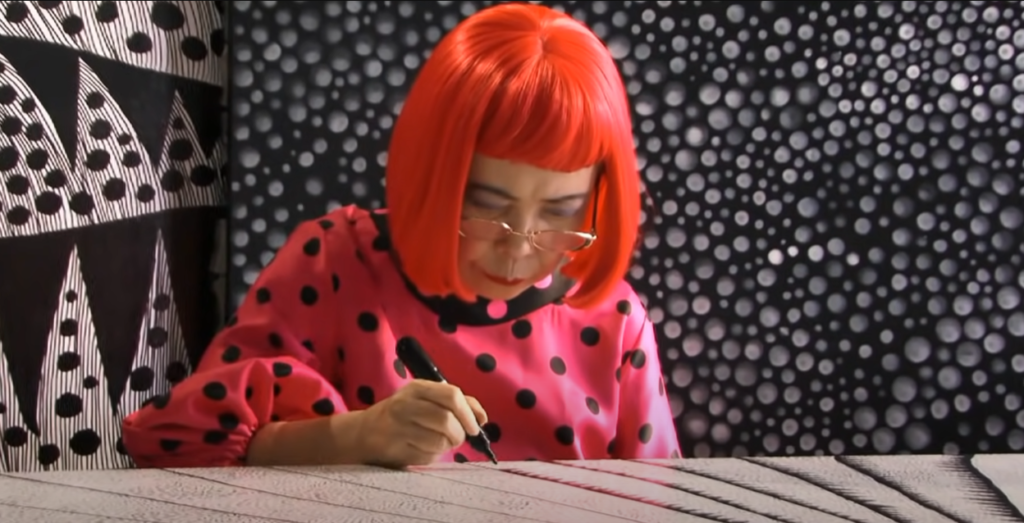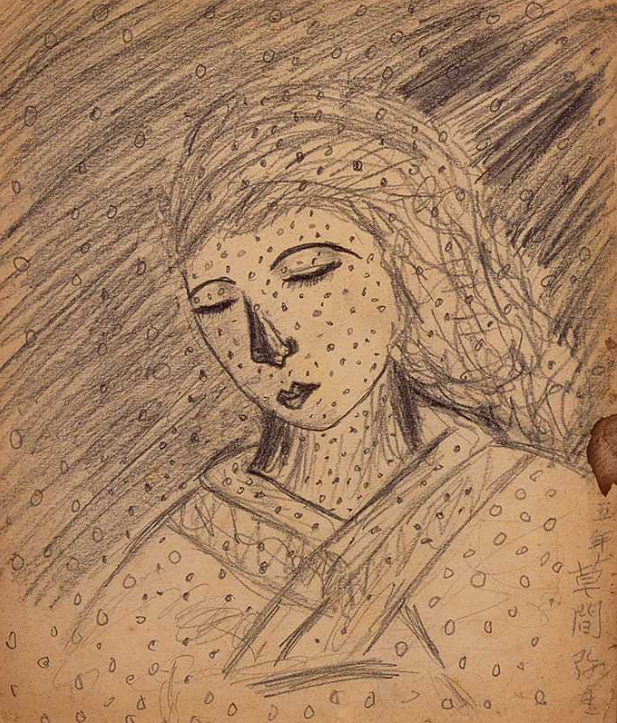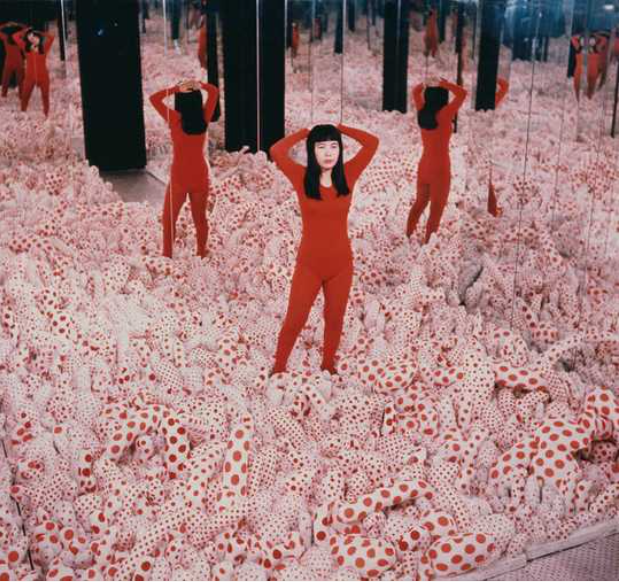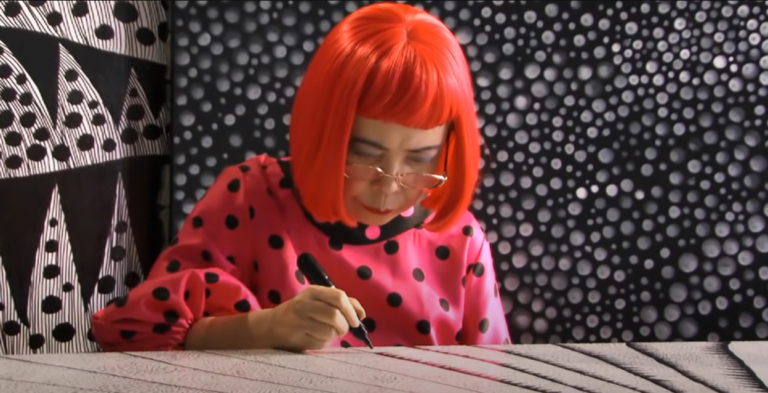Who is Yayoi Kusama?

Yayoi Kusama is a Japanese contemporary artist and writer. Known particularly for her extensive use of polka dots in her work, as well as her infinity rooms that embrace the viewer in her artwork. She is known worldwide as an artist with her works showcased in various exhibitions all around the world and she has recently collaborated with Louis Vuitton for her latest collection.
From her struggle with recognition to becoming a worldwide sensation, Yayoi Kusama began as an artist at a young age. Her first drawing was with polka dots at the age of 10. Unfortunately, for much of her life, Kusama was an unrecognized artist, with barely anything of a cult following. It was only in 1989 when she was 60-plus years of age that she finally exploded on the worldwide stage when The Centre of International Contemporary Arts in New York asked to stage a retrospective of her art that relaunched her career.
Yayoi Kusama’s Art and Hallucinations: Her Obsession With Polka Dots
Since childhood, Kusama suffers from a mental illness that causes her to have visual and aural hallucinations. Particularly at 10 years old she began seeing a field of dots, and at that young age, she drew an image of her mother covered in dots. In comparison to other artists who used polka dots as a stylistic choice, Kusama drew her polka dots in a repetitive motion as a way to overcome her fear and anxiety. It was a way to “self-obliterate”, a way to disappear into her artwork.
Yayoi Kusama’s Infinity Mirror Rooms

In America, Kusama continued to develop herself as an artist and in 1965 arranged an installation artwork that encouraged viewers to be enveloped by the artwork. It contained white phallic soft structures with red polka dots and had mirrors all around which caused the viewer to lack control of how they viewed the art.
It is very reminiscent of how Yayoi Kusama controls her mental illness through her artwork. Lack of control over her health has caused her to try to control every aspect of her life to cope with it, including the way her audience views her artwork.
Stepping into one of her infinity rooms could also be perceived how Yayoi Kusama experiences her visual hallucinations as you are surrounded by polka dots, in the same way, she feels the polka dots consumes her.
How Yayoi Kusama’s Childhood Experiences Add to Her Art
Born in 1929 in Matsumoto Japan, Yayoi Kusama grew up in a rural provincial town in Japan to a wealthy family. Kusama did not get along with her parents, as they were very traditional. Her parents disliked her love for art and wanted her to conform to an arranged marriage. Her mother was also against her wish to become an artist and did everything in her power to stop Kusama from having any career at all as she thought it would bring shame upon their traditional Japanese family.

This is a drawing Kusama painted of her mother.
But to Kusama, art was her lifeline, it helped relieve her hallucinations, depression, and anxiety which she still suffers from today. Kusama has described how at times, she feels her whole body functions breaking down, with her feelings of being “absorbed” or “dissolved” by her surrounding environment. For Yayoi Kusama, expressing herself through art is a way of taking back control, to fight her demons.
In 1941 when Japan was at war, the 12 yr old Kusama found herself sewing military parachutes in textile factories. This was a skill she would later utilize for her soft sculptures.
As a child, Kusama was also forced to spy on her father by her mother, and when she caught her father with his mistress, her mother became very angry. The anger of her mother caused Kusama to be averse to sex lifelong.
As a child, she was forced by her mother to spy on her father. Such an intense responsibility was forced upon her as a young child, and she caught her father with his mistress. Her mother’s anger and having caught her father in an affair caused her to have psychological trauma, creating a lifelong aversion to sex. However, this could have also in part contributed to her work with soft phallic sculptures.
Discovering America For Yayoi Kusama
Kusama’s childhood was fraught with breaking free of traditional Japanese society, she fought back against being in an arranged marriage her family wanted for her. Instead, she pursued being an artist, wanting to create a career for herself which her mother tried to stop her from having as it would bring “shame to the family”.
In rural Japan, while browsing a second-hand bookshop, she stumbled across a book with the paintings of American artist Georgia O’Keeffe. At this time, O’Keeffe was one of the most famous artists in the world. Every major museum in the US featured her works but in secluded Japan, barely anyone knew about her. This was Kusama’s first encounter with O’Keeffe’s paintings which greatly inspired her, but most of all, Kusama was enraptured with O’Keeffe’s achievements as a woman.
Kusama sent letters to O’Keeffe with some of her drawings and amazingly O’Keeffe received the letters, and not only took the time to write back but then sent letters of introduction to important people in the New York art world.
O’Keeffe must have had enough of an impact on Kusama that she states she began to consider Japanese society “too small, too servile, too feudalistic, and too scornful of women.” In July 1956, Kusama destroyed 2000 pieces of work she created that were at her parents’ home, in a move to signify a new start and her preparation to move to the United States in 1957. She didn’t return to Japan until 1973.
Striving For Recognition
Yayoi Kusama went from being a wealthy daughter in Japan whose life was panned out for her by her parents, to poverty in New York City. She survived on a diet of potatoes, onions, and black coffee, which drove her to crave fame.
Her time in America was fraught with struggles, she was a Japanese artist in a land full of white artists. She barely spoke any English, and she would beg museums to showcase her art. It was during this time that she already had begun experimenting with her trademark polka dots, drawing on animals, paper, canvas, walls, naked bodies, and herself.
Her first infinity mirror room in New York was in 1965. It featured her soft phallic sculpture with her iconic polka dot motif in different sizes all around the room. Unfortunately, during this time, although Yayoi Kusama worked hard and had several shows, at a time when her male peers were more highly regarded than female artists, she received little recognition for her work.

Recognizing Artists Is So Important
Kusama has addressed how she felt her work was “co-opted” by male artists who showcased their art in more established galleries. Although Kusama said it wasn’t the idea of being ripped off that bothered her, but rather the lack of acknowledgment.
Two instances that might have been artists ‘stealing’ Kusama’s work were firstly through Claes Oldenburg, who was working with hard materials. Just months after Kusama’s exhibition of soft sculptural works, he put on a show with soft sculptures, which launched his international career. On the other hand, Kusama received very little recognition for her art form.
There is also Andy Warhol, whom Kusama thought of as a close friend. In an interview, she said “Any Warhol came to the show and admired my wallpaper images. He said “Wow. Fantastic Yayoi, I like this so much.” Unfortunately, later he proceeded to cover the Leo Castelli gallery with wallpaper in the same manner that Kusama used to. She sank into depression and retreated to her studio, covering all her windows so nobody could steal her ideas, and she worked in secret.
Why did Yayoi Kusama Leave New York?
Eventually, overwhelmed with depression and the lack of recognition for her work, in 1973 she decided to go back to Tokyo for her health. Starting over, Kusama was virtually unknown and thus dismissed as an artist in Japan, and it was hard for her to keep painting.
In 1977, she checked herself into a Tokyo Psychiatric Hospital, to take care of her mental health because she constantly suffered from fighting anxiety and hallucinations. She remains on medication to prevent depression and suicidal thoughts. Every single day she commutes to her studio and works obsessively on her paintings from 9 am to 6 pm.
In 1989, Kusama reached 60 years old. An important birthday in Japanese culture symbolizes a new start, and it certainly was for Kusama. Unexpectedly The Centre for International Contemporary Arts in New York asked to stage a retrospective of her work. This propelled her onto the international art scene and was just the beginning of her journey to fame.
Conclusion
Kusama’s art is deeply personal and is considered a pioneer in minimalism, sculpture, and installation art. Some of Kusama’s earliest surviving paintings relate to the horrors of war which she vividly remembers. In 1967 whilst in New York, she organized anti-war protests known as “Atomic Explosions”. Kusama has always thrown herself into the art scene, painting herself with polka dots and frequently taking pictures with her artwork.
Part of Kusama’s art is her own persona. Ever since she began her work in America, she would dress in polka dots, using herself as a canvas. It is no surprise that she is so heavily emphasized in the Louis Vuitton x Yayoi Kusama collaboration because they were giving her what she truly wanted all along. Fame, and for her art to be seen across the world.
READ MORE: All You Need to Know About the Louis Vuitton x Yayoi Kusama Collection
